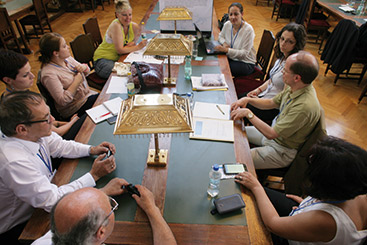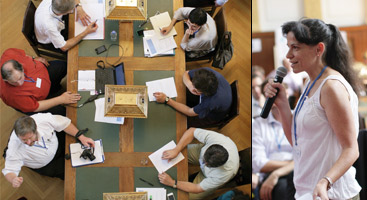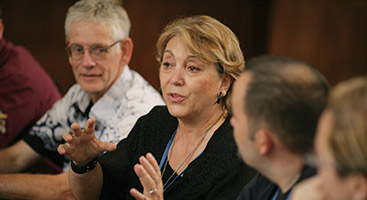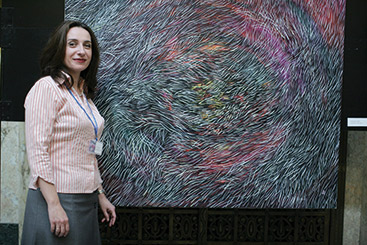The Voice of the Danube

The Voice of the Danube
In early July, more than 80 stakeholders of the ICPDR attended a workshop where they expressed their views on the draft Danube River Basin Management Plan and Danube Flood Risk Management Plan. The event marks the peak of an intense public consultation campaign, which aims to involve the people of the Danube in the drafting of ICPDR policies from the beginning.

“A sediment management tool is needed. Rivers should also be passable for sediments.“
It was an intense programme that lasted over a day and a half: a workshop under the title Voice of the Danube, which gave policy makers of the ICPDR an opportunity to learn about the needs of those affected by these policies – the people of the Danube Basin. The two draft management plans – the Danube River Basin Management Plan and the Danube Flood Risk Management Plan – were discussed in detail to provide input before they are finalised in the autumn. These two plans will be the most important work programmes for the ICPDR until 2021.
The workshop organisers, the ICPDR in cooperation with Global Water Partnership, put great emphasis on limited presentations to allow for as much discussion time as possible. This resulted in lively contributions from more than 80 participants.
In order to extract knowledge from everybody attending the workshop, the so-called Danube Café format was chosen. The participants were divided into five working groups. Guided by a facilitator and watched closely by a rapporteur, the groups spent approximately 30 minutes in discussion, before the facilitator and
rapporteur moved and the next topic was presented to the group.
This approach guaranteed that everybody worked on every topic in small groups regardless of their specialisation – hydropower specialists discussed wetland reconnection, biodiversity experts spoke about climate change, corporate represent atives reflected on the need for increasing flood retention spaces. The potpourri of delegates and the original format ensured there was a maximum of creativity in the discussion.
The five topics at the core of this discussion reflected the main topics of the two management plans: hazardous substance and nutrient pollution, hydromorphological alterations and integration issues, public participation and communication, flood risk management, and the financing of measures proposed by the plans.
In addition, observer organisations and other stakeholders had a chance to present statements, join in plenary discussions or raise questions in writing. The workshop was opened by ICPDR President Dražen Kurečić, who recalled the importance of the two management plans for the years to come and their considerable impact on the lives of people, not least in the light of the devastating floods that the Sava sub-basin experienced last year.
The Art Nouveau building of the Croatian National Archive provided an appropriate frame for the workshop: symbols of wisdom and scholastic traditions on walls and façades provided a source of intellectual inspiration. Modern media linked the traditional venue with the world outside – all presentations were published via a live stream and social media such as Twitter and Facebook allowed for direct interaction with the public – 39 tweets from the event resulted in nearly 7000 impressions and numerous interactions.
And now that the Voice of the Danube has spoken, it is up to the ICPDR to take its messages on board. The comments collected are currently structured and will feed into a report provided to the relevant ICPDR expert groups who will then revise the management plans in the autumn. They will be adopted by the ICPDR at its plenary meeting in December, and by then a final report on all public consultation work will be published. Each comment will be recorded in this report with a note explaining either how it was taken into consideration or on what grounds it was dismissed. In either case, the opinions expressed by the stakeholders will be treated with utmost respect.




The Voice of the Danube workshop was part of a range of public consultation efforts for the draft Danube River Basin Management Plan Update 2015 and the first Flood Risk Management Plan for the Danube River. Other measures in line with this included a social media campaign, online questionnaires and the collection of comments submitted in writing. All four of these consultation channels will contribute to a final report.
Public consultation is required by the Water Framework Directive; however, the ICPDR goes far beyond these legal requirements in its commitment to involve stakeholders. This is because the commission is convinced that active public participation facilitates broader support for policies and leads to increased efficiency in the implementation of measures. Public participation is an ongoing process and builds on the involvement of 23 observer organisations in ICPDR expert groups, public information activities, outreach and consultation work.

“In my paintings I try to recreate the movement of water in the river, which is in perpetual motion, headlong, rebellious, changing constantly in new colours and picturesque structures,” says Bratislava-based Bulgarian artist Radostina Doganova when explaining her paintings. Ms Doganova generously provided several large-format oil paintings with a Danube theme. Every stakeholder views the river differently – what could possibly be a better means to link everybody with the Danube than an abstract reflection on the river provided by art?
Learn more about Ms Doganova’s artwork at:
www.radostinadoganova.com





